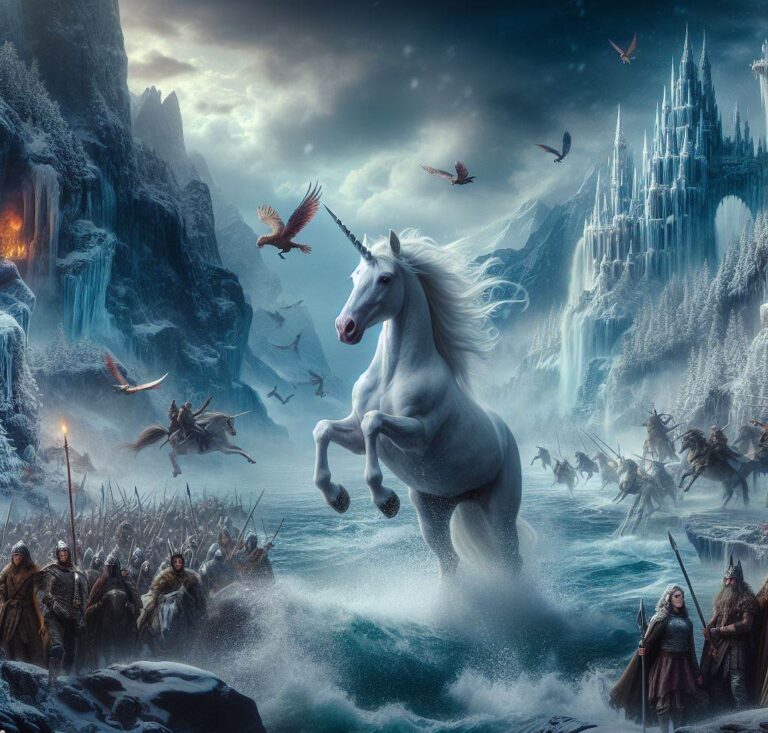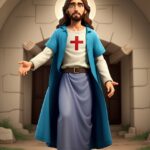Exploring the depths of history, Narnia: The Last Battle unveils a gripping tale that transcends time and leaves a profound impact on its readers. Authored by C.S. Lewis, this extraordinary fantasy book delves into a historic event that has fascinated humanity for centuries.
Prepare to be captivated as we unveil the untold secrets and pivotal moments of “The Last Battle,” bringing to life a chapter of history that will leave you spellbound.
The Chronicles of Narnia The Last Battle: Full Book Summary
Once upon a time, in the magical land of Narnia, there lived a group of talking animals, brave kings and queens, and many other delightful creatures. In this land, where animals talked and trees could move, there was always an adventure waiting just around the corner. But little did they know, the greatest adventure of all was about to begin in their final battle against evil.
In the last book of the Chronicles of Narnia, “The Last Battle,” we find ourselves back in this beloved land. Narnia was a place where animals and humans once lived in harmony, but something had changed. A false ruler named Shift, a cunning ape, had manipulated a donkey named Puzzle into dressing up as the lion, Aslan, and pretending to be their glorious leader.
Shift and Puzzle planned to control Narnia and become the supreme power. Slowly, they started to impose unjust laws and bring darkness upon the land. The animals and the rightful rulers of Narnia, King Tirian and his loyal companions, were deeply saddened by the state of their once magnificent kingdom. They knew something had to be done, but their efforts felt futile against the might of the false Aslan.
Meanwhile, back in our world, a group of children, named Jill and Eustace, found themselves unexpectedly transported to Narnia by Aslan himself. They were given a mission, a task of the utmost importance. Aslan had appeared to them in the form of a mighty lion to give them a warning and a purpose.
Jill and Eustace learned that the real Narnia was in grave danger, and they were chosen to help save it. Aslan instructed them to find King Tirian and assist him in his struggle against evil. With hope and determination in their hearts, the two children set out on their journey, guided by none other than the great lion himself.
Upon their arrival in Narnia, Jill and Eustace encountered many challenges and temptations. They traveled through treacherous lands, overcome by darkness and confusion. Aslan was always there, watching over them, ready to guide them back on the right path whenever they strayed.
In their travels, the children discovered some of their old friends from previous adventures in Narnia, such as Puddleglum the Marsh-wiggle, a loyal and wise creature who joined their quest. Together, they faced many dangers, fought off enemies, and persevered with the hope of restoring Narnia to its former glory.
Eventually, Jill, Eustace, and their newfound companions reached King Tirian. They shared what they had learned about the false Aslan and his wicked plans. King Tirian was relieved to have them on his side, and together, they devised a plan to reveal the truth to the rest of Narnia.
The brave group infiltrated the Narnian gathering, where the falsely dressed Puzzle was presenting himself as Aslan. King Tirian and his friends exposed the deception, causing an uproar among the Narnian citizens. The animals and creatures of Narnia began to question the false ruler and his motives.
But the false Aslan had cunning tricks up his sleeve. With the help of Shift, the ape, he convinced many Narnians that they had to fight against the old ways and against the true rulers of Narnia. The land was plunged into chaos, and the battle between good and evil intensified.
Aslan’s followers, including the brave children, King Tirian, and his loyal friends, fought valiantly against the forces of darkness. All seemed lost, but just when it seemed that evil would prevail, a miraculous turn of events occurred. Aslan, the true Aslan, appeared in all his glory and power.
The great lion, Aslan, unleashed his golden mane and roared with a mighty voice. He summoned all his strength to defeat the false Aslan and bring justice to Narnia. In one swift motion, the false ruler and his treacherous companion were banished from the land.
Peace was restored to Narnia, and the rightful rulers assumed their thrones once more. Aslan rewarded Jill and Eustace for their bravery and perseverance by allowing them to stay in Narnia forever. They would get to experience the joy and beauty of this magical land for eternity.
Narnia was at peace once again, and all the creatures rejoiced. The dark days were over, and the land flourished with happiness, kindness, and harmony. The Last Battle had been fought, and good triumphed over evil.
As the story comes to a close, we learn that Narnia was merely a glimpse of the true and eternal kingdom that awaits beyond the boundaries of our own world. Through their adventures, the children and all the wonderful characters of Narnia taught us valuable lessons about courage, loyalty, and the power of good over evil.
The Last Battle: Key Themes
The Last Battle is the final installment in C.S. Lewis’ beloved Chronicles of Narnia series. Published in 1956, this book continues the adventures of the Pevensie children and their journey in the magical world of Narnia. The story revolves around the climactic battle between the forces of good and evil, as well as the ultimate fate of Narnia itself.
1. Betrayal and Deception: One of the prominent themes in The Last Battle is the idea of betrayal and deception. The story begins with a false Aslan appearing and a group of cunning Calormenes attempting to deceive the inhabitants of Narnia. Through these actions, Lewis explores the consequences of trust misplaced and the dangers of manipulation. The characters are forced to confront their own vulnerabilities and discern truth from falsehood. Ultimately, the theme of betrayal highlights the importance of discernment and loyalty.
2. Faith and Belief: Throughout the book, faith and belief play a crucial role in the characters’ journey. As Narnia faces its final battle, Lewis delves into the complexities of faith and the various forms it can take. The unwavering faith of characters like Tirian and Jewel, who remain loyal to Aslan even in the face of doubt and despair, represents the importance of holding onto one’s convictions. Additionally, Lewis explores the idea of faith being tested, as characters grapple with doubts and temptations. By discussing faith from different perspectives, the author invites readers to reflect on their own understanding of belief and the resilience it demands.
3. The Afterlife and Salvation: Another key theme in The Last Battle is the concept of the afterlife and salvation. As the story progresses, it becomes evident that Narnia itself is on the brink of destruction, and the characters must find a way to reach Aslan’s country, which represents a heavenly realm. This journey serves as an allegory for the Christian belief in salvation and the promise of an eternal life. Lewis offers a vision of redemption and emphasizes the importance of embracing goodness and staying true to one’s principles, as it is these qualities that ultimately lead the characters to their salvation.
In conclusion, The Last Battle explores themes of betrayal and deception, faith and belief, and the afterlife and salvation. C.S. Lewis masterfully weaves these themes together to create a thought-provoking conclusion to the Chronicles of Narnia series, leaving readers with profound reflections on loyalty, spirituality, and the nature of the human condition.
The Last Battle: Characters
1. King Tirian: The brave and noble ruler of Narnia, King Tirian possesses a regal presence and a heart of gold. His golden locks flow down to his broad shoulders, complementing his striking azure eyes. Known for his unwavering loyalty to his people, Tirian fearlessly leads Narnia’s last stand against the forces of evil, displaying immense courage and resilience at every turn.
2. Jill Pole: A spirited and kind-hearted adventurer, Jill Pole is a true friend to Narnia. With her fiery red hair and mischievous freckles, Jill’s infectious laughter can light up any room. Her quick thinking and resourcefulness often save the day, as she fearlessly dives into danger to help her comrades. She also has an uncanny ability to talk to animals, making her a valuable ally in tricky situations.
3. Eustace Scrubb: Eustace, originally introduced in “The Voyage of the Dawn Treader,” returns to Narnia alongside Jill. With his ever-present pessimism and sarcastic remarks, Eustace provides comedic relief amidst the chaos. Sporting glasses that constantly slip down his nose, he begrudgingly finds himself fighting alongside the forces of good. Deep down, Eustace possesses a surprising bravery and slowly learns the power of friendship and trust.
4. Jewel the Unicorn: A majestic and proud creature, Jewel is a unicorn with a heart as pure as his gleaming silver horn. Renowned for his agility and grace, he becomes a steadfast companion to the Narnians. Jewel’s shimmering white coat is his crowning glory, occasionally causing him to be mistaken for an ethereal apparition. He loves engaging in philosophical discussions and has an affinity for lighthearted pranks, often surprising his friends with amusing antics.
5. Puzzle the Donkey: The unlikely hero of the story, Puzzle may not be the sharpest tool in the shed, but his unwavering loyalty to his friends is second to none. With his unkempt gray fur and large drooping ears, Puzzle’s clumsiness often results in comedic mishaps. However, his unwavering determination and unexpected acts of bravery win the hearts of those around him, proving that true heroism can come in the most unassuming packages.
6. Shift the Ape: The cunning and manipulative villain, Shift is an ape notorious for his deceitful ways. With his hunched posture and unnaturally long arms, Shift uses his physical resemblance to humans to exploit the more naive creatures of Narnia. His insatiable hunger for power leads him to orchestrate a diabolical scheme, pitting Narnia’s creatures against one another. Despite his malicious nature, Shift’s exaggerated gestures and over-the-top vocalizations provide moments of dark humor.
7. Mr. and Mrs. Beaver: This lovable duo brings warmth and wisdom to the story. Mr. Beaver, with his stout build and gray fur, exudes reliability and a strong work ethic. His razor-sharp teeth and ability to gnaw through practically anything come in handy during perilous situations. Mrs. Beaver, on the other hand, is a nurturing figure with her warm smile and pearl-like scales adorning her tail. Known for her exquisite baking skills, she often surprises her friends with delicious treats, helping to build bonds of camaraderie.
8. Aslan: The great lion and the true heart of Narnia, Aslan’s majestic presence alone commands respect and awe. His golden mane shimmers in the sunlight, contrasting with his divine emerald eyes. Aslan embodies wisdom, power, and unconditional love, guiding the heroes on their quest and providing moments of clarity in times of uncertainty. Though gentle and serene, his roar can shake the very foundations of the world, ensuring evil crumbles in his wake.
The Last Battle: Symbols
1) The Stable Door: The Stable Door is a significant symbol in “The Last Battle.” It represents the barrier between the earthly realm of Narnia and the heavenly realm of Aslan’s country. It serves as a portal that leads the characters from one world to another, symbolizing the transition from life to death and the passage to the afterlife. It also represents the choice between faith and doubt, as those who believe in Aslan’s country are willing to step through the door, while those who do not are hesitant or refuse to enter.
2) The Golden Fern: The Golden Fern is a symbol of hope and restoration throughout the book. When the characters discover the fern growing in a desolate land, it signifies the presence of Aslan and the promise of renewal. The fern also represents the power of belief and the possibility of finding beauty and joy even in the darkest times.
3) The Silver Chair: The Silver Chair is a powerful symbol in “The Last Battle.” It represents deception, false authority, and the manipulation of truth. In the story, the Silver Chair is used by the ape Shift and the false Aslan to control and manipulate the characters, obscuring their vision and leading them astray. The Silver Chair highlights the dangers of misleading leadership and blind obedience without questioning or seeking the truth. It also serves as a reminder to stay vigilant and discerning in the face of falsehoods.
The Last Battle: Culture Impact
Published in 1956, “The Last Battle” by C.S. Lewis is the final installment of the beloved Chronicles of Narnia series. This epic tale, set in the magical land of Narnia, has left an indelible mark on popular culture, ensuring its enduring legacy for generations to come.
From a historic perspective, “The Last Battle” emerged during a time of great change and upheaval. The post-World War II era was marked by a need for hope, a desire for escape from the harsh realities of the world. Lewis understood this, and through his allegorical fiction, he provided readers with a respite from their everyday lives. The book offered a sense of wonder, inspiring millions to look beyond the confines of reality and embrace the power of imagination.
Funny and whimsical, “The Last Battle” introduced readers to memorable characters like Puddleglum, the pessimistic Marshwiggle, who provided comic relief amidst the novel’s darker themes. Puddleglum’s dry humor and unexpected heroism endeared him to readers and became an iconic figure in literary comedy. Countless quotes and memes featuring his witty remarks still circulate today, proving the enduring comedic impact of Lewis’ work.
Beyond its entertainment value, “The Last Battle” achieved remarkable literary and cultural milestones. The book delves into profound themes such as faith, betrayal, and the struggle between good and evil. Through its exploration of religious allegories, Lewis seamlessly wove Christianity into the narrative, making it accessible to readers of all ages and backgrounds. This subtle approach helped pave the way for religious literature to be more widely accepted, inspiring a new wave of faith-based storytelling.
Moreover, “The Last Battle” underscored the potent message of unity and resilience in the face of adversity. In the context of the Narnian world, the series paralleled the importance of standing up against injustice and oppression. This resonated deeply with readers during moments of social and political turmoil, leaving a lasting impression that continues to be celebrated today.
In the decades since its publication, “The Last Battle” has achieved monumental success, with the Chronicles of Narnia series selling over 100 million copies worldwide. The book has also been adapted into critically acclaimed films and stage productions, further solidifying its place in popular culture.
In conclusion, “The Last Battle” has left an indelible cultural impact. It provided an escape during times of global unrest, brought laughter through captivating characters, and explored profound themes that inspired readers. Lewis’s magnum opus remains a significant contribution to literature and continues to enchant audiences, reminding us of the transformative power of storytelling.
FAQs
1. Is “The Last Battle” the final book in the Chronicles of Narnia series?
Yes, “The Last Battle” is indeed the seventh and final book in the Chronicles of Narnia series written by C.S. Lewis.
2. How many books are there in the Chronicles of Narnia series?
The Chronicles of Narnia series consists of a total of seven books, starting with “The Lion, the Witch and the Wardrobe” and concluding with “The Last Battle.”
3. Can “The Last Battle” be read as a standalone book or is it important to read the previous books in the series?
While “The Last Battle” can be enjoyed as a standalone story, it is highly recommended to read the previous books in the series to fully understand the characters, their journey, and the depth of the Narnia universe.
4. What is the main plot of “The Last Battle”?
“The Last Battle” takes place in Narnia and follows a group of friends who join forces to save the land from an evil ape named Shift and his false Aslan. The story explores themes of faith, loyalty, and the ultimate battle between good and evil.
5. Is “The Last Battle” suitable for children or is it more geared towards adult readers?
“The Last Battle” is generally considered suitable for both older children and adult readers. However, some younger readers may find certain scenes or themes in the book darker and more intense compared to the earlier books in the series. Parental guidance is recommended for younger readers.
6. What is the summary of The Last Battle?
The Last Battle is a fantasy novel by C.S. Lewis, set in the world of Narnia. It tells the story of the end of the world of Narnia and the fate of its characters. A false Aslan is set up by a cunning ape and a Calormene prince, who use him to enslave and deceive the Narnians. King Tirian and his loyal friends fight against them, but are outnumbered and captured. They call for help from Aslan, who sends the children from our world to rescue them. Aslan then judges all the creatures of Narnia and destroys the old world. He welcomes the faithful Narnians into his real country, which is a new and better Narnia.
7. What are the Christian themes in The Last Battle?
The Last Battle explores various Christian themes, such as the end times, the Antichrist, the final judgment, heaven, and hell. The false Aslan represents the Antichrist, who deceives many people with lies and miracles. The last battle represents the final conflict between good and evil. The stable represents the door to the afterlife, where Aslan judges everyone according to their deeds and beliefs. The real country of Aslan represents heaven, where the faithful Narnians enjoy eternal joy and peace. The dark and silent place represents hell, where the unbelievers and traitors are banished.
8. Who are the main characters in The Last Battle?
The main characters in The Last Battle are:
- King Tirian: The last king of Narnia, who is brave, loyal, and noble. He leads the resistance against the false Aslan and the Calormenes. He is the great-grandson of King Rilian and the descendant of King Caspian X.
- Jewel: A talking unicorn, who is Tirian’s best friend and companion. He is faithful, wise, and gentle. He fights alongside Tirian and follows him to the end.
- Shift: A clever and greedy ape, who is the mastermind behind the false Aslan plot. He manipulates Puzzle, the Calormenes, and the Narnians to gain power and wealth. He is cunning, selfish, and cruel.
- Puzzle: A simple and kind donkey, who is Shift’s servant and victim. He wears a lion’s skin to impersonate Aslan, but he is reluctant and unhappy about it. He is naive, timid, and good-hearted.
- Rishda Tarkaan: A Calormene nobleman and captain, who is Shift’s ally and co-conspirator. He leads the invasion of Narnia and the persecution of the Narnians. He is ambitious, ruthless, and cunning.
- Eustace Scrubb and Jill Pole: Two children from our world, who have been to Narnia before. They are summoned by Aslan to help Tirian and his friends. They are brave, loyal, and adventurous.
- Peter, Edmund, Lucy, Polly, and Digory: Five children from our world, who have been to Narnia before. They are the former kings and queens of Narnia and the witnesses of its creation. They arrive in Narnia after the last battle and join Aslan in his real country. They are wise, noble, and loving.
9. How does The Last Battle fit in the Narnia series?
The Last Battle is the seventh and final book in the Narnia series, but the third book in the publication order. It takes place about 200 Narnian years after The Silver Chair and about 2500 Narnian years after The Magician’s Nephew. It is the only book in the series that does not feature any children from our world as the main protagonists, but rather focuses on the native inhabitants of Narnia and its neighboring lands. It is also the only book in the series that does not have a happy ending in Narnia, but rather shows the destruction of the old world and the transition to the new one.
10. What is the moral of The Last Battle?
The moral of The Last Battle is that God has a plan for everyone’s life, and that He works in mysterious ways to accomplish His purposes. The main characters learn to trust and follow Aslan, even when they do not understand His ways or see His presence. They also learn to overcome their flaws and weaknesses, such as pride, fear, and prejudice, and to embrace their true identities and destinies. The book also shows the contrast between the cultures of Narnia and Calormen, and the values of freedom, justice, and love versus oppression, deception, and lust.










